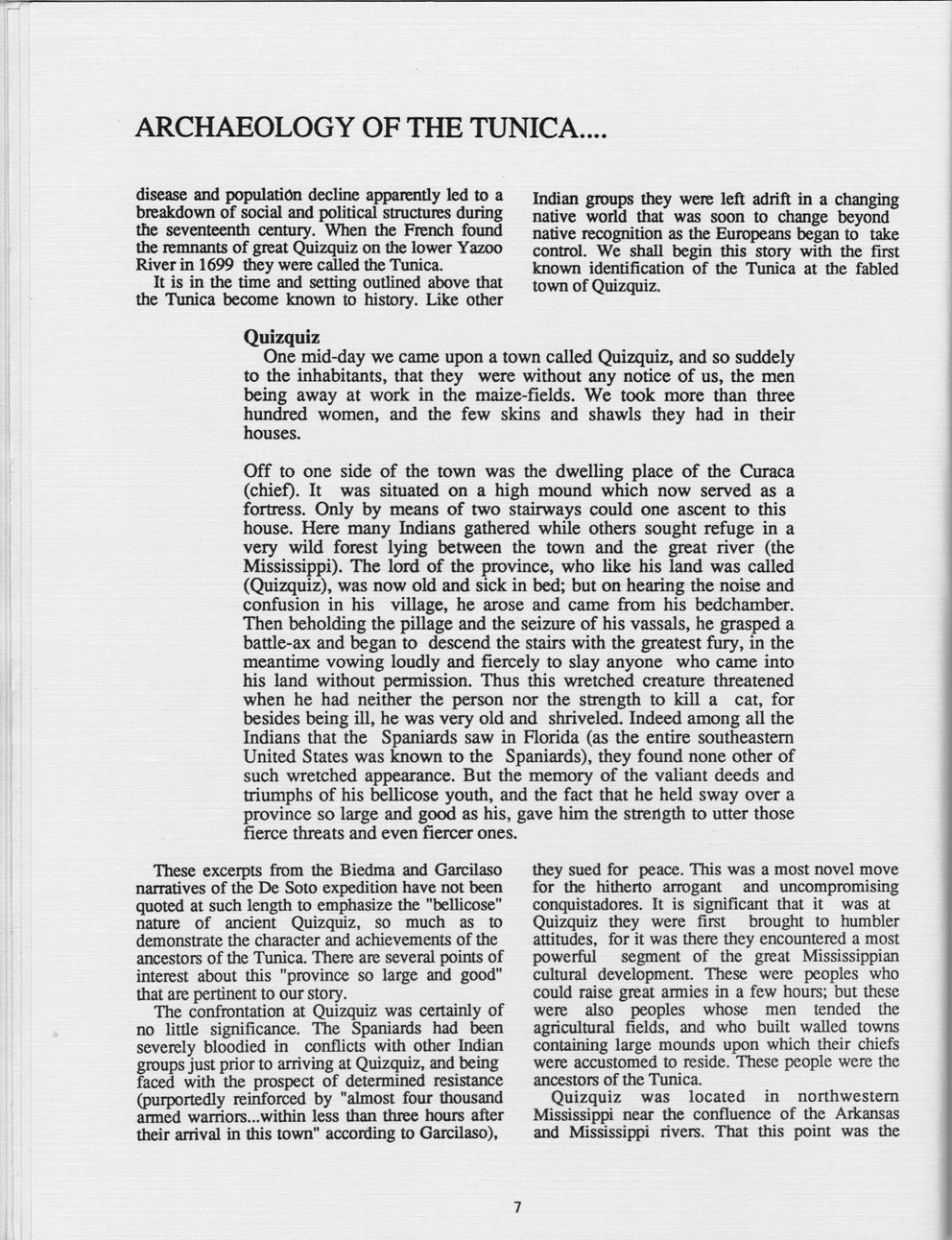This text was obtained via automated optical character recognition.
It has not been edited and may therefore contain several errors.
ARCHAEOLOGY OF THE TUNICA.... disease and population decline apparently led to a breakdown of social and political structures during the seventeenth century. When the French found the remnants of great Quizquiz on the lower Yazoo River in 1699 they were called the Tunica. It is in the time and setting outlined above that the Tunica become known to history. Like other Indian groups they were left adrift in a changing native world that was soon to change beyond native recognition as the Europeans began to take control. We shall begin this story with the first known identification of the Tunica at the fabled town of Quizquiz. Quizquiz One mid-day we came upon a town called Quizquiz, and so suddely to the inhabitants, that they were without any notice of us, the men being away at work in the maize-fields. We took more than three hundred women, and the few skins and shawls they had in their houses. Off to one side of the town was the dwelling place of the Curaca (chief). It was situated on a high mound which now served as a fortress. Only by means of two stairways could one ascent to this house. Here many Indians gathered while others sought refuge in a very wild forest lying between the town and the great river (the Mississippi). The lord of the province, who like his land was called (Quizquiz), was now old and sick in bed; but on hearing the noise and confusion in his village, he arose and came from his bedchamber. Then beholding the pillage and the seizure of his vassals, he grasped a battle-ax and began to descend the stairs with the greatest fury, in the meantime vowing loudly and fiercely to slay anyone who came into his land without permission. Thus this wretched creature threatened when he had neither the person nor the strength to kill a cat, for besides being ill, he was very old and shriveled. Indeed among all the Indians that the Spaniards saw in Florida (as the entire southeastern United States was known to the Spaniards), they found none other of such wretched appearance. But the memory of the valiant deeds and triumphs of his bellicose youth, and the fact that he held sway over a province so large and good as his, gave him the strength to utter those fierce threats and even fiercer ones. These excerpts from the Biedma and Garcilaso narratives of the De Soto expedition have not been quoted at such length to emphasize the "bellicose" nature of ancient Quizquiz, so much as to demonstrate the character and achievements of the ancestors of the Tunica. There are several points of interest about this "province so large and good" that are pertinent to our story. The confrontation at Quizquiz was certainly of no little significance. The Spaniards had been severely bloodied in conflicts with other Indian groups just prior to arriving at Quizquiz, and being faced with the prospect of determined resistance (purportedly reinforced by "almost four thousand armed warriors...within less than three hours after their arrival in this town" according to Garcilaso), they sued for peace. This was a most novel move for the hitherto arrogant and uncompromising conquistadores. It is significant that it was at Quizquiz they were first brought to humbler attitudes, for it was there they encountered a most powerful segment of the great Mississippian cultural development. These were peoples who could raise great armies in a few hours; but these were also peoples whose men tended the agricultural fields, and who built walled towns containing large mounds upon which their chiefs were accustomed to reside. These people were the ancestors of the Tunica. Quizquiz was located in northwestern Mississippi near the confluence of the Arkansas and Mississippi rivers. That this point was the 7

Native Americans The-Tunica-Biloxi-Tribe-its-Culture-and-People-(14)